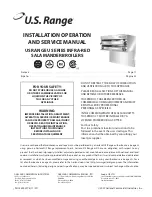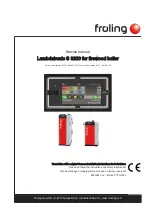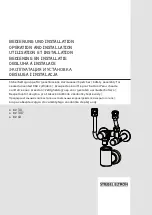
4
NORMAL OPERATION
Installation, user and maintenance manual – AY Condensing line, AY Series
17
4�5
PROLONGED PERIODS OF DISUSE
When the appliance is to be inactive for a long period, it is necessary to disconnect the appliance before the period of disuse and
reconnect it before it is used again.
To carry out these operations, contact a reputable hydraulic system installation technician.
Disconnecting the appliance before the period of disuse
You will need: the appliance connected to the power/gas supply. Necessary equipment and materials.
1.
if the appliance is in operation, switch it off with the DDC (or other consent switches) and wait for the shutdown cycle to ter-
minate completely (approximately 3 minutes).
2.
Close the gas cock (if compatible with the antifreeze functions) (Paragraphs 5.6
→
25 and 5.7
→
25).
3.
Switch off the DDC (if present).
4.
Disconnect the appliance from the mains (if compatible with antifreeze functions, Paragraphs 5.6
→
25 and 5.7
→
25), and set
the external power switch in the electrical panel to "OFF" (GS - see Paragraph 6.1
→
34).
Do not leave the appliance connected to the power and gas supply if it is expected to remain inactive for a long period.
If the appliance is disconnected in the run up to winter, make sure that there is a sufficient glycol concentration in the inter-
nal and system circuits: see "Possible use of glycol antifreeze" and Table 5.3
→
25.
Connecting the appliance before it is used again (to be carried out by the installation technician)
Before starting this procedure, the hydraulic system installation technician must:
▶
Ascertain whether the appliance requires any maintenance (contact your authorised Robur Technical Assistance Centre or refer
to Paragraph 7.2
→
53);
▶
check that the water content of the plant is correct; if necessary, top up the circuit to at least the minimum quantity (see Para-
graph 5.6
→
25);
▶
if necessary, add inhibited monoethylene glycol antifreeze (free of impurities) in a quantity in proportion to the MINIMUM winter
temperature in the area of installation (see Table 5.3
→
25);
▶
bring the plant to the correct pressure, making sure that the pressure of the water in the plant is not less than 1 bar and not over
2 bar.
In case of winter saesonal switch-off or long period of stopping, we suggest to not empty the hydraulic circuit: in that case
possible oxidation process can occur.This oxidation process could damage both the hydraulic system and also the Robur
heat pump.It’s important to verify that no leakages occur in the hydraulic circuit that may empty part of the system. The
above recommendation is necessary in order to avoid to fill continuously with water that may imply the additional introduc-
tion of oxygen and the consequent dilution of the used inhibitor, for ex glycol. In case of precence of glycol, Robur advices
to use inhibited glycol. Galvanized pipes are not recommended, as they are not compatible with glycol.
You will need: the appliance disconnected from the electricity and gas supply. Necessary equipment and materials.
1.
Open the gas supply tap to the plant and ascertain that there is no smell of gas (indicating possible leaks);
if you smell gas, close the gas valve again immediately without operating any other electrical device and, from a safe place,
request the assistance of professionally qualified personnel.
1.
If no smell of gas is detected, connect the appliance to the electricity supply mains via the external disconnecting switch
provided by the installation technician in the appropriate panel (set the "GS" disconnecting switch to the "ON" position - see
Paragraph 6.1
→
34).
2.
Power up the DDC (if present).
3.
Check that the hydraulic plant is suitably sized to guarantee the correct water flow.
4.
Switch the appliance on with the DDC (or other consent switches).
5.
Ascertain whether the appliance requires any maintenance (refer to Paragraph 7.2
→
53). In particular, check the operation of
the condensate siphon.
Icing of condensate during the period of disuse can lead to a permanent locked condition. In this case, the first symptom
would be a lack of condensate draining in condensation mode (outlet water temperature less than 50 °C).
















































